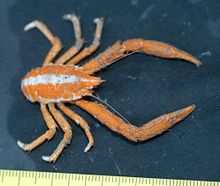

| Munidopsis
| |
|---|---|

| |
| Munidopsis serricornis | |
| Scientific classification | |
| Domain: | Eukaryota |
| Kingdom: | Animalia |
| Phylum: | Arthropoda |
| Class: | Malacostraca |
| Order: | Decapoda |
| Suborder: | Pleocyemata |
| Infraorder: | Anomura |
| Family: | Munidopsidae |
| Genus: | Munidopsis Whiteaves, 1874 |
| Type species | |
| Munidopsis curvirostra Whiteaves, 1874 | |
Munidopsis is a genus of squat lobster. It is the second largest of all the genera of squat lobsters, after Munida, with over 200 species.[1] Its members are mainly found on continental slopes and on abyssal plains.[1] A few fossil species are also known,[2] including specimens from the Campanian (Cretaceous).
There are currently over 230 known species.[3]
Munidopsis, like other squat lobsters, are often found in chemosynthetic environments in the ocean.[4]
Munidopsis was the first confirmed genus to inhabit the underwater Mud volcano habitat.[4]
Most Munidopsis species are found in the deep sea at depths more than 5300m.[3]
In 2022, during surveys of the wreck of the Endurance, a squat lobster believed to be an unidentified species in the Munidopsis genus was observed.[5]
The genus Munidopsis dates back to the Eocene and Upper Cretaceous of Antarctica.[6]
The described living species are as follows:[7]